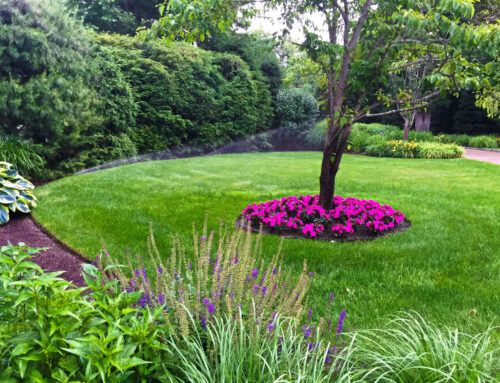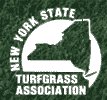Like it or not, winter’s coming. And we have some news for you: You’ve got some winterizing to do.
The pretty plants, lush lawn, sparkling pool, tranquil pond and reliable sprinkling system that gave you so much pleasure over the summer are all calling out for a bit of help.
If you want them to be there for you, healthy and in good working order when spring rolls around, they need some attention now, before the snow flies.
Homeowners, let’s take a look at the steps you should take to get your landscape ready for winter, including plantings, turf, pools, ponds, and irrigation.
Grab a cup of hot cider and put your feet up. Pretty soon, you’re going to be really busy.
How To Winterize Your Garden In 4 Steps
We get it — after a long summer tending to your lawn and garden, it’s tempting to stash, or smash, the garden tools.
It’s fall now — the yard can take care of itself, right?
Not exactly. There’s stuff to be done.
Your yard and landscape still need some tender loving care to ensure a healthy start next spring. Ignore it now, and you’ll be sorry come tulip time.
Divide Plants
If your perennials are overcrowded, fall is a great time to divide the root ball and replant. Cut plants back before you transplant them and they’ll be happier during the move.
Don’t Forget To Water
Plants are still thirsty and need a good long drink before they bed down for the winter. Water early in the day to avoid disease. Water deeply.
Don’t forget your trees. They may seem self-sufficient, but their roots need plenty of moisture to make it through the upcoming months.
Clean Up Garden Beds
Remove weeds and debris so pests won’t make your garden their winter home. Cleaning away dead plant matter will prevent the growth of fungi and viruses.
Fruits and vegetables left in the garden can rot all winter long, and provide the perfect home for insect eggs. That would be a lovely greeting come spring.
Protect Cold-Sensitive Plants
Many shrubs, roses and perennials hate blasts of icy cold. Tuck them under a cozy bed of mulch or another protective covering.
How To Winterize Your Lawn In 5 Steps
Your lawn may seem ready to just bed down for the winter, but it will be greener and healthier in the spring if you tend to a few needs now.
Remove Leaves
Clear leaves now and it will save you some work in the spring. It will also keep the heavy, wet leaves from suffocating your turf. Dark, wet environments are breeding grounds for disease.
Here’s the good news: no more raking and bagging. Just mow over those fallen leaves to chop them into tiny bits. It’s called mulching, and it saves you work and also improves your lawn.
As the chopped leaves decompose, they boost the soil with valuable nutrients. Your lawn will get a great nitrogen boost — it’s free fertilizer.
Feed Your Lawn
Experts say if you only do it once a year, fall is the time to feed your lawn.
As the weather gets cooler, the green blades of grass grow more slowly, but there’s plenty of action beneath the ground. The roots are growing quickly. That means they’re hungry.
Fertilize in the fall and you give those roots nutrients to grow nice and deep now, with some left over for a healthy start next spring.
Apply a dry lawn fertilizer in mid- to late fall.
Aerate Your Lawn
Your lawn gets a lot of use during the summer. That can cause the soil to become compacted.
Perforating your lawn with small holes lets water, air, and fertilizer get down to the soil, which strengthens the roots and makes for a healthier lawn.
It’s called aeration. You can rent the hulking machines and attempt the job yourself. But this is one of those tasks best left to the professionals. The machines are heavy and cumbersome, and figuring out the exact best time to aerate can be tricky.
Seed, Seed, Seed
Most grasses in New York and Connecticut grow best in cool weather. So fall is a great time to plant the seed.
But don’t wait too late — your new grass will need about a month before the first frost to get established.
Attack Those Weeds
The weeds are winding down, which means fall is a great time to attack. Hit them with an herbicide or hunker down and yank them by hand.
Most herbicide manufacturers recommend applying the weed killer during early to mid-autumn when daytime temperatures are above 60 degrees.
How To Winterize Your Pool In 8 Steps
Closing down your pool for the winter takes some work, but each step is important to keep things protected.
This is actually one of the most important times of year for your pool. Close it up right, and you’ll avoid unnecessary problems and costly repairs in the spring.
Each pool is different, and your pool might need specific attention not addressed here, but our experts at Neave Pools run through the basic pool closing steps.
Balance The Water
A few days before closing your pool, make sure your water chemistry is balanced. This includes the pH, total alkalinity, and calcium hardness. This will protect the surface of the pool from staining and etching.
Shock the water with chlorine to kill bacteria that may be living in the pool. Look for a product with at least 65 percent sodium hypochlorite or a non-chlorine substitute of equivalent strength. Fill a 5-gallon bucket with pool water, add the instructed amount of shock granules, and pour it into the pool while the filtration system is running.
Take Everything Out Of The Pool
Remove the skimmer baskets, heaters, slide, any wall fittings, vacuums, pool cleaners, ladders, handrails, or anything else that shouldn’t be in the pool.
Rinse all of the pool equipment and lay it out to thoroughly dry.
Skim, Vacuum, and Brush The Pool
Use a pool skimmer to remove anything floating on the top of the pool, including leaves, insects, and any other debris. Be thorough. This is the last skimming before winter. Vacuum and brush the pool.
Lower The Water Level
You can either use your filter pump or a submersible pump to lower your pool water level. You’ll need to lower the level about 4 to 6 inches below the lowest plumbing line, normally the water return line. Be sure the water level is at least below the skimmer.
Drain Your Pump, Filters, Heaters, And Chlorinating Equipment
Your pump, filter, heater, and chlorinator all have a drain plug. Either drain the water out of these or blow the line out with a shop vac. This will ensure all of the water has drained and none is left inside any plumbing lines.
Pick a place to put all the plugs so you can find them again in the spring. Maybe in the skimmer basket you just removed from the pool?
Empty Your Chemical Feeder
If you have a chemical feeder, now is a good time to drain and empty it. If you leave chemicals in your chemical feeder over the winter, you might damage your equipment.
Cover The Swimming Pool
Time for the cover. It’s important to use a cover that fits well and doesn’t leave any gaps or cracks.
How To Winterize Your Sprinkler System
Don’t forget one of the most important landscape tasks of late fall.
Just like the water that freezes and slicks up your driveway, any water left in your underground sprinkler system will freeze, too, damaging equipment and leading to costly repairs in the spring.
Even if you’ve drained the water out of your irrigation system, some water remains and can freeze, expand, and crack the piping.
Every drop of water has to be blown out of the pipes and heads before winter blasts in.
Step One: Call A Professional — Seriously
Winterizing your irrigation system is one of those jobs best left to a professional.
Why? Your home air compressor just isn’t powerful enough to blow out your sprinkler system. The heavier water will remain in the pipes, potentially freezing and breaking parts of your system.
Professionals know how to adjust air compressor pressure to the water pressure your system uses, preventing any damage to your sprinkler heads and pipes.
Experts with a professional landscape service like Neave Irrigation don’t just blow out the water from your system — they also review the system as they go. As they winterize, they’ll look for heads that don’t work or that are positioned too low.
They’ll make notes on necessary tasks for spring servicing, so your system will be up and running smoothly as soon as your lawn needs water.
How To Winterize Your Pond In 4 Steps
It’s tempting to just ignore your pond until spring, but taking care of a few winterizing tasks now will keep it healthy for another season of tranquility.
Clean Your Pond Thoroughly
Get the muck out. Especially if your pond is located near other elements in your landscape, there’s a good chance that falling leaves and other debris will have gotten into the pond as autumn has set in.
You may also need to change out your water if it’s discolored or dirty, but it’s actually a safer bet to leave water be, if possible.
Replacing the current contents of your pond with new water may be too much for fish to handle before the weather cools down much more.
Prepare Your Plants
If there are tropical plants in your pond, you’ll want to remove those and either take care of them indoors during the winter or treat them as annuals and replace them when the weather warms up next year.
Hardy aquatic plants? Leave those in the water, but move them to the deepest part of the pond for the best winter protection.
First, cut those plants back as much as you can, removing excess leaves and flowers so they don’t decompose and clog up your pond.
Create Air Flow
Whether you leave your pump and filtration system running or disconnect and store it for the winter is up to you.
But you’ll need to find a way to keep oxygen coming in, and help gases escape that have formed at the bottom of the pond as a result of your fish, decomposing plants, and more.
One option: Install a heater for your pond, to keep one spot on the surface of the water warm enough so it doesn’t freeze.
You may also want to purchase an air pump to keep the air moving if you’ve opted to disconnect your pump and filtration system.
Protect Your Fish
Fish hibernate, snoozing right through the worst of the winter. Lucky fish.
Once the weather chills, they need a lot less food, and their heartbeats slow to about one beat per minute.
To keep fish alive during the winter, there should be a spot in your pond deeper than two and a half feet so that fish can descend to that low point where the water is less likely to freeze. If you have a small, shallow pond, buying a small heater may do the trick to keep the water warm enough for them.
As long as you’ve left that hole for oxygen to get in and other gases to escape, your fish should be able to ride out the winter just fine.
Whew! That’s A Lot Of Work! Or, Just Call Neave
So, you’re either empowered by all the information you’ve just received OR you’re exhausted from the thought of what it takes to properly winterize your landscape. Imagine how tired you’ll be actually doing it all.
Better yet, call Neave. Neave Outdoor Solutions has experts in landscape maintenance, turf care, pools, ponds and irrigation.
We’re your one-stop for all your property’s winterization needs.
Our professionals will get your property all tucked in for winter, so you can spend your fall days making that famous chili of yours and watching football.
If you’re in the Hudson Valley, call us at (845) 463-0592. If you’re in Westchester County, call (914) 271-7996; from Connecticut, dial (203) 212-4800. Or, fill out our simple web form, and we’ll contact you about setting up your free consultation.
Images: Frosted plant, Dead leaves in garden, Pulling weeds, Fish pond in winter,
























